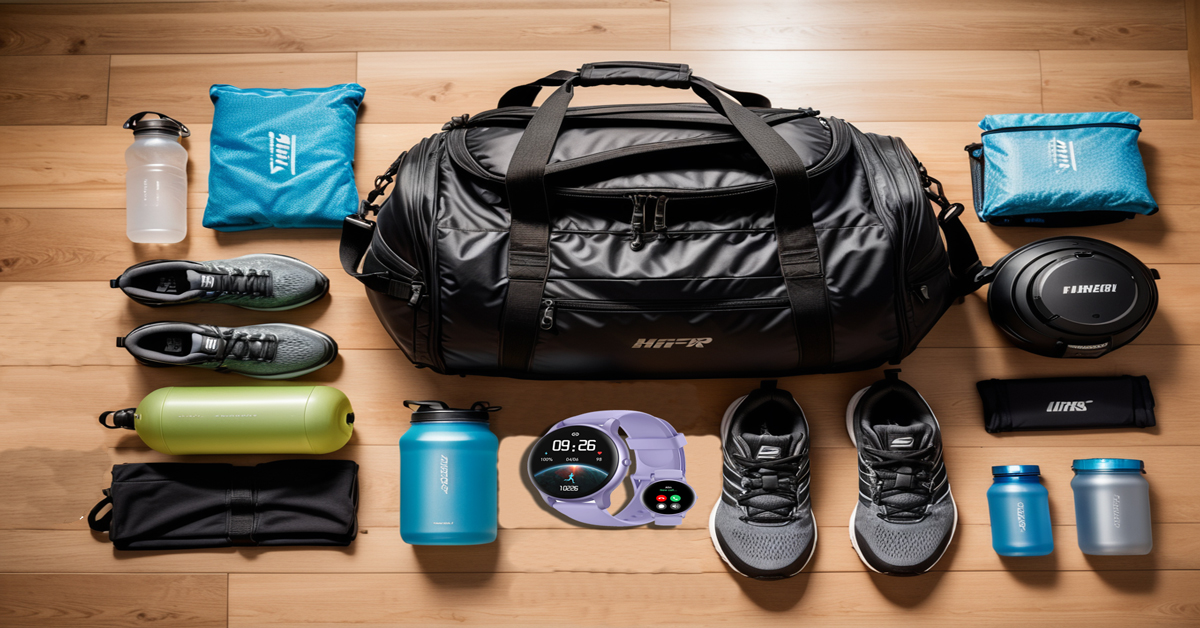Stay Fit on the Go: Essential Tips for Healthy Travelers
Traveling often disrupts routines, making it challenging to maintain fitness and wellness. Staying fit while on the go is entirely achievable with the right strategies and mindset. With a little planning and creativity, one can integrate physical activity and healthy eating into their travel itinerary, ensuring that their journey remains enjoyable and invigorating.
Simple adjustments can lead to significant benefits during trips. From packing essential gear to incorporating workouts into the day, travelers can stay active while exploring new destinations. Prioritizing wellness not only enhances physical health but also boosts mental well-being, making trips more rewarding.
To navigate the challenges of travel, embracing a proactive approach will yield the best results. Keeping the body fueled and exercise consistent can transform travel into an opportunity for health rather than a setback.
Key Takeaways
• Prioritize fitness by packing convenient workout essentials.
• Maintain a balanced diet to support health during travels.
• Integrate physical activity into daily routines for better well-being.
Packing Essentials for Fitness
When traveling, it is crucial to select the right workout gear and nutrition options that facilitate maintaining fitness routines. Appropriate packing can significantly enhance the travel experience by ensuring that exercise and healthy eating remain accessible.
Workout Gear Selection
Choosing the right workout gear is vital for staying active on the go. Lightweight and packable items are ideal. Here are some essentials to consider:
• Clothing: Opt for moisture-wicking fabrics that dry quickly. A couple of workout shirts and shorts can be folded compactly.
• Footwear: Invest in a pair of versatile sneakers that provide good support and can serve multiple activities.
• Accessories: Don’t forget a travel-friendly yoga mat, resistance bands, or a jump rope. These items are portable and offer diverse workout options.
• Water Bottle: A reusable water bottle is essential to stay hydrated during workouts.
Select items that fit easily into luggage without taking up too much space.
Portable Nutrition Choices
Maintaining a balanced diet while traveling can be challenging, but portable nutrition options make it easier. Focus on packing snacks that are both healthy and convenient. Suggested items include:
• Protein Bars: Look for those with minimal added sugars and a good protein content.
• Nuts and Seeds: These are packed with nutrients and provide lasting energy. Opt for portioned packs to control intake.
• Dried Fruits: They offer natural sweetness and important vitamins. Choose unsweetened varieties when possible.
• Powdered Supplements: Protein powder and meal replacement powders can be easily mixed with water or milk for quick nutrition. Consider storing these in resealable bags for easy access during travel.
Maintaining a Healthy Diet
Travel can disrupt regular eating routines, making it essential to adopt specific strategies. By planning smart eating habits and staying hydrated, travelers can achieve their nutritional goals while on the go.

Smart Eating Strategies
Travelers should prioritize making informed food choices. When dining out, opting for grilled, steamed, or baked options is advisable. Avoid fried foods and cream-based sauces, as these can add unnecessary calories.
Planning meals in advance can prevent impulse decisions. When possible, carry healthy snacks, such as nuts, fruits, or granola bars, to manage hunger between meals. This approach also helps to reduce reliance on fast food.
Additionally, when ordering, travelers can request dressings or sauces on the side. This simple tactic allows for better control over portion sizes and calorie intake. Choosing dishes with whole grains, lean proteins, and plenty of vegetables enhances nutritional value.
Hydration Habits
Staying adequately hydrated is crucial while traveling. Travelers should aim to drink water consistently throughout the day, especially in environments where dehydration can occur, such as airplanes or warm climates.
Avoid sugary beverages like sodas and energy drinks. These can lead to unnecessary calorie intake and negatively impact energy levels. Instead, focus on water, herbal teas, or infusions for flavor without added sugars.
To make hydration practical, carrying a reusable water bottle is recommended. This not only provides easy access to water but also helps in tracking daily intake. A standard goal is to drink at least 8 cups (2 liters) of water daily, adjusting for activity level or climate as needed.
Exercise On the Move
Maintaining a fitness routine while traveling requires adaptability and creativity. Various in-room options and local facilities can provide effective solutions for staying active on the go.
In-Room Fitness Options
Travelers can leverage the space in their hotel rooms for workouts that require minimal equipment. Bodyweight exercises are particularly effective. Here are some exercises that can be easily performed:
• Push-Ups: Strengthens the chest, shoulders, and triceps.
• Chair Dips: Target the triceps using the edge of a chair.
• Squats: Works the lower body; can be enhanced with heel raises.
• Plank: Strengthens the core, requiring only a few square feet.
A quick session of 15-20 minutes incorporating these movements can keep one energized. Creating a circuit of 2–3 sets of each exercise helps to maintain momentum.
Utilizing Local Facilities
Exploring local facilities can further enhance a traveler’s fitness routine. Many hotels offer gyms equipped with:

• Cardio Machines: Treadmills, stationary bikes, and ellipticals are common.
• Free Weights: Dumbbells allow for a greater variety of exercises.
• Yoga Mats: Perfect for stretching and core workouts. For those preferring outdoor activities, parks often provide:
• Running Trails: Great for cardio.
• Exercise Stations: Public fitness areas equipped with equipment. Travelers should prioritize finding nearby options when planning their itinerary. Some mobile apps can help locate gyms or wellness facilities quickly.
Managing Stress and Sleep
Travel often brings excitement but can also lead to increased stress and disrupted sleep. Understanding how to manage these elements is crucial for maintaining well-being while on the move.
Mindfulness and Relaxation Techniques
Incorporating mindfulness practices can significantly reduce travel-related stress. Techniques such as deep breathing, progressive muscle relaxation, and meditation are valuable tools.
1. Deep Breathing: Take a few minutes to focus on breathing deeply. Inhale through the nose, hold for a moment, then exhale slowly through the mouth. This helps calm the nervous system.
2. Guided Meditation: Using apps like Headspace or Calm can facilitate meditation even in unfamiliar environments. Short sessions can enhance mental clarity.
3. Journaling: Writing thoughts before sleeping can clear the mind. Keeping a travel journal helps process experiences and emotions. These methods empower travelers to stay grounded and maintain emotional balance.
Sleep Quality Improvement
Quality sleep is essential for recovery and well-being. Travelers often face challenges such as time zone changes and noisy environments. Implementing strategies to enhance sleep can be beneficial.
1. Consistent Sleep Schedule: Try to maintain a routine even when traveling. Go to bed and wake up at similar times daily.
2. Comfortable Environment: Create a conducive sleep atmosphere. Use earplugs, sleep masks, or white noise apps to block distractions.
3. Limit Screen Time: Reducing exposure to screens at least one hour before bed can improve sleep quality. The blue light emitted can interfere with melatonin production.
4. Healthy Evening Routines: Engage in calming activities prior to sleep. Reading or taking a warm bath can signal the body that it is time to rest. rest. By prioritizing sleep and employing relaxation techniques, travelers can enhance their overall well-being.
Staying Active During Transit
Traveling often involves long periods of sitting. This can lead to discomfort and fatigue. Here are some practical ways to stay active during transit:

1. Walk Whenever Possible: In airports, train stations, or bus terminals, choose to walk instead of using moving sidewalks or shuttles.
2. Stretch: Take breaks to stretch your legs. Simple stretches can improve circulation and relieve tension. Consider the following stretches:
Neck rolls
Hamstring stretches
Shoulder shrugs
3. Use Your Luggage:
While waiting, engage your core by doing light lifts with your carry-on bag. This can serve as a mini workout.
4. Bodyweight Exercises:
In a discreet area, perform exercises like squats or calf raises. These can be done quickly and don’t require any equipment.
5. Stay Hydrated:
Drink water regularly. Staying hydrated helps maintain energy levels and promotes movement.
6. Choose Active Modes of Transportation:
If feasible, opt for walking or biking to your accommodation instead of taxis or rideshares.
Incorporating these activities can make a difference in maintaining fitness levels during travel. Plan ahead to incorporate these tips during your journey.





